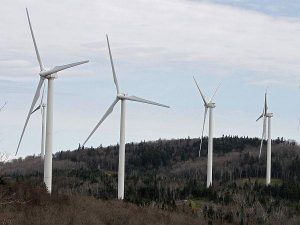 Vermont’s Public Service Board has released a draft of new rules for wind turbine siting which embraces a happy medium approach that should minimize adverse effects from noise, while providing wind developers the option of negotiating participation agreements with neighbors who are willing to live closer to turbines than the rules would stipulate.
Vermont’s Public Service Board has released a draft of new rules for wind turbine siting which embraces a happy medium approach that should minimize adverse effects from noise, while providing wind developers the option of negotiating participation agreements with neighbors who are willing to live closer to turbines than the rules would stipulate.
Current Vermont wind projects are required to keep noise at non-participating homes lower than 45dB outside and 30dB inside; this inside/outside distinction has become a primary bone of contention (especially in summer with open windows), and some sound monitoring has found occasional periods in which noise was slightly above the limits. 45dB is a widely-used noise limit, though it’s also a level at which noise can be quite prominent and disruptive at times.
The new draft rule adopts a fairly precautionary approach, in line with some of the stricter rules that have been appearing elsewhere in places where turbine noise has triggered discontent: the PSB calls for a daytime limit of 42dB and a nighttime limit of 35dB, measured 100 feet from non-participating homes. In addition, the rules call for setbacks of 10x the blade-tip height of the turbines; modern turbines range from 450 to 500 feet tall, meaning that this would push turbines back to more than three-quarters of a mile from homes—which is more or less in line with what would be necessary to meet those sound limits (in fact, the nighttime limit may be a challenge at times for turbines at this distance; see this post about some sound monitoring done about 4500 feet from the closest turbine at the Sheffield Wind Farm). This is a step quieter than some other areas, where nighttime limits of 40-42dB have become more common in recent years. It’s in line with current noise standards in rural areas of Germany and Oregon, and with routine 2km (1.2 mile) setbacks in place in Scotland, and with some parts of Australia, where setbacks tend to range from 1-2km, with rural noise limits of 35dB.
Both community advocates and wind industry representatives were surprised at how tight the PSB’s proposed noise limits are. “If there were these setbacks, and if the noise standards could be enforced at these levels, it would very much be helpful to the people of Vermont who have to live around these things,” said Annette Smith of Vermonters for a Clean Environment, which has been supporting neighbors that have been impacted by turbine noise in the state. Meanwhile, Ben Walsh, climate and energy program director at the Vermont Public Interest Research Group, sees the nighttime limits as a deal breaker: “That is absurdly low. This is functionally a ban on wind large and small in Vermont … I’m surprised the board went this far.”
Overlooked in initial reactions is a clause in the draft rule that defines “participating landowner” not as those actually hosting turbines on their land, but rather, “a landowner who has signed a written agreement with a Petitioner stating that the sound emissions standards established by this rule do not apply to the landowner’s property.” I suspect that this clause will give developers the flexibility they need to proceed with projects in areas with relatively few homes within a mile or so, which is really where they should be aiming to build anyway. Areas with many homes within easy earshot of wind farms are likely to become problematic for a critical mass of residents. Serious noise issues are relatively rare, affecting a small minority of those within earshot, though those who are affected often experience life-altering impacts; at the same time, many people are aware that they are not particularly sensitive to noise, and will be willing to live with modest or occasionally louder noise in exchange for modest compensation. It’s a tricker proposition all around to navigate the “participating landowner” exceptions to these stricter siting standards, but it’s a reasonable choice to make if the PSB is aiming to minimize negative impacts on unwilling neighbors.
The draft rules will be subject to two public meetings as well as review and approval by two state agencies, so stay tuned through the spring as these standards move toward finalization. The draft rule should be posted here soon.
Into the weeds: A key element of any sound regulation is the protocol for doing field measurements to check for compliance. Peak sound levels are hardly ever used; some degree of averaging is typical, ranging from ten minutes to 24 hours. In this case, the draft rule calls for a minimum of twelve 10-minute averages to be combined; thus, at best, this will mean we’re looking at sound averages over two hours. However, as also typical, the 10-minute periods need to all have no extraneous sounds, and also be representative of the conditions being tested for (the rule notes that this will often be night time periods with relatively high winds). Thus the rule allows for two different sets of 6 periods, gathered on different days, be combined to create the average being considered. In all situations, the loudest valid 10-minute period must be included in the averages. Bottom line: there can and likely will be times when the sound is louder than the stated regulatory threshold, but these periods must be short enough that these 2-hour averages stay below the threshold.

March 11th, 2017 at 7:24 pm
Interesting post, Jim. Good to see noise taken seriously as an issue with wind turbines, although is seems that siting them further and further from human developments just places them in the backyards of our wild neighbors, of which several species have been shown to be negatively affected by the spinning blades. Catch-22.